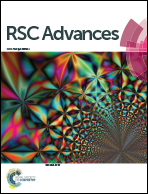Bienzymatically crosslinked gelatin/hyaluronic acid interpenetrating network hydrogels: preparation and characterization
Abstract
Hydrogels that mimic the extracellular matrix in both composition and crosslinking chemistry have great potential in the development of tissue engineering scaffolds. Natural polymer hydrogels crosslinked by enzymes have excellent biocompatibility due to their natural origin and the mild reaction conditions, but usually suffer from a lack of mechanical strength. In order to improve the mechanical properties, hydrogels of gelatin/hyaluronic acid with interpenetrating network (IPN) structure were prepared by dual enzymatic crosslinking, using transglutaminase (mTG) to crosslink gelatin, and horseradish peroxidase (HRP) to crosslink hyaluronic acid (HA) grafted with tyramine (HA-Ty), respectively. The gelation processes of the gelatin/HA IPN hydrogels were monitored by rheometer. The data confirmed the formation of dual networks: one gelatin network crosslinked by mTG and the other HA network crosslinked by HRP. Hereafter, the results of mechanical test showed the compressive strength of the gelatin/HA-Ty IPN hydrogels was 10 folds higher than that of pure HA hydrogels. Furthermore, the in vitro enzymatic degradation, equilibrium water content, cytotoxicity and cell adhesion of the IPN hydrogels were evaluated in detail. The preliminary biological evaluation revealed the hydrogels could support cell adhesion and proliferation. Summary, the gelatin/HA IPN hydrogels prepared by bienzymatic crosslinking method possess excellent biocompatibility and mechanical properties, which are expected to be novel biomaterials in the field of tissue engineering and in situ wound repair.


 Please wait while we load your content...
Please wait while we load your content...